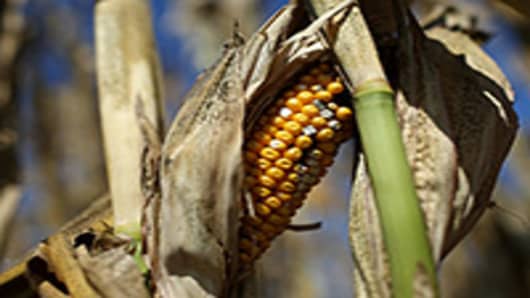The drought has been awful for farmers, but it could reap a bumper crop of good news for the seed business. With much of this year's corn harvest expected to be a disaster, analysts expect farmers to double down on seed purchases next year to get back on their feet.
"Tight seed supply is set to drive up pricing," wrote Michael Cox of PiperJaffray.
Of particular interest are a new batch of seeds bred specifically to withstand drought. The only one commercially available on a wide scale is Optimum AQUAmax by Pioneer, owned by DuPont . These seeds are hybrids using native corn traits, promising 3.4 percent better yields than other hybrids in normal years, and 7 percent better yields in drought. (Related:Obama Announces Measures to Soothe Drought Pain)
"We've sold out," said Pioneer's Todd Frazier, Central Business Unit Director, "We would've liked to have more."
Pioneer sold two million acres worth of AQUAmax this year and hopes to increase that "several fold" next year. It beat Monsanto to market, but Monsanto has its own drought-tolerant corn seed coming soon. Syngenta also has drought-tolerant corn seed which will be available on a large scale next year. Like Pioneer, Syngenta's product uses only corn traits to fight drought. DroughtGard by Monsanto, which is currently being field tested, is a biotech seed using genetic material from other plants as well to develop drought fighting characteristics.
Tuesday, Monsanto reaffirmed guidance and said DroughtGard will focus on farmers in the Plains who average 70 to 130 bushels an acre annually. That is much lower than the 160 to 200 bushels an acre farmers in the heart of the cornbelt enjoy in a normal year.
Except this is not a normal year. The U.S. Department of Agriculture currently estimates the national average on yield will be 126 bushels an acre, the lowest in 17 years.
The global seed market grew from $31 billion in 2005 to $41 billion last year, according to Mindwork Solutions. Its research estimates the market will top $58 billion by 2016, with about a third of all seeds being sold the result of some sort of genetic engineering.
If climate change is real and long term, the market for drought-tolerant seeds could be the next big profit center. Pioneer said by using only native corn traits in AQUAmax, it can sell the seeds in Europe, a market that may be closed to Monsanto's DroughtGard.
No seed can survive without some water, but Pioneer's technical staff said farmers are telling them the seeds are performing well.
"Oh, that's a good ear," said Brent Wilson as he pulled corn off an AQUAmax stalk. Wilson is Pioneer's point man with many farmers.
"When we hit some of those really dry days, the leaves will kind of curl up when they get under moisture stress, trying to protect themselves," he said, adding that farmers are telling him, "AQUAmax hybrids were able to maintain that leaf area, which is really the engine that drives yield production."
The drought is impacting Pioneer's own seed production, but Todd Frazier said the company will have enough to meet next season's demand. "We mitigate the risk in those seed fields by growing extra."
And while a seven percent better yield for seeds that cost twice as much may not sound like the best deal, Brent Wilson said any improvement will help the bottom line.
"At $8.60 corn, ka-ching, it starts to rack up," he said.
—By CNBC's Jane Wells
@janewells



